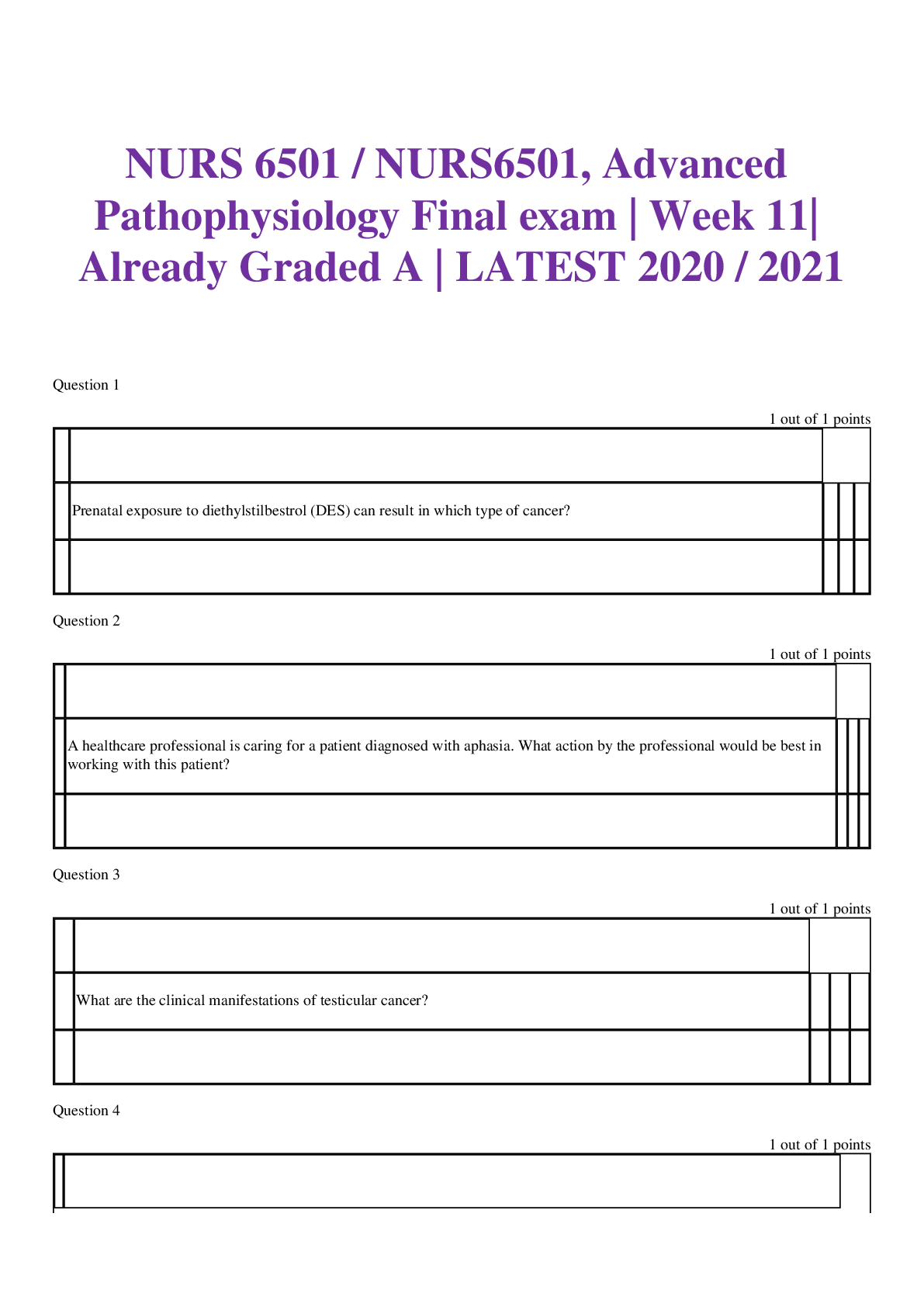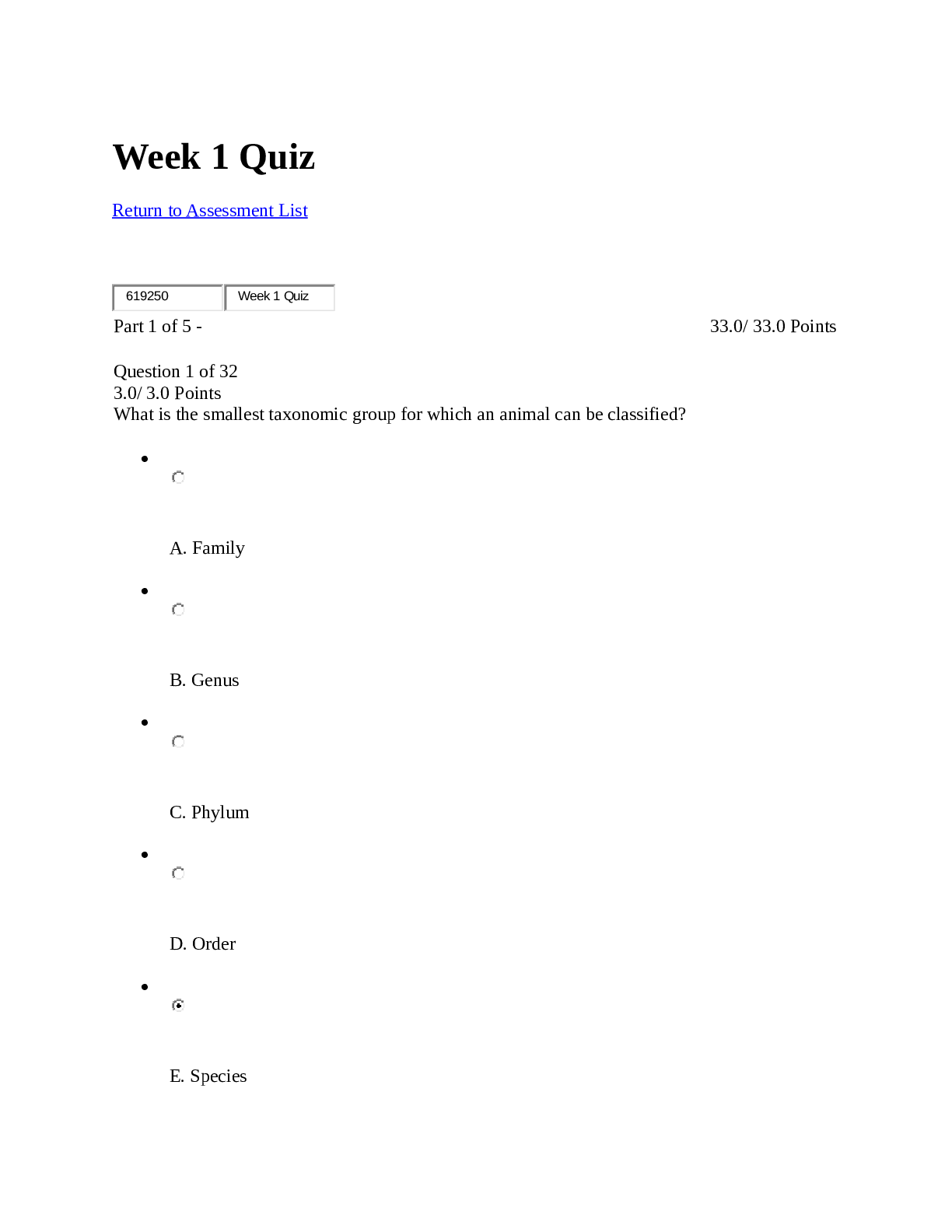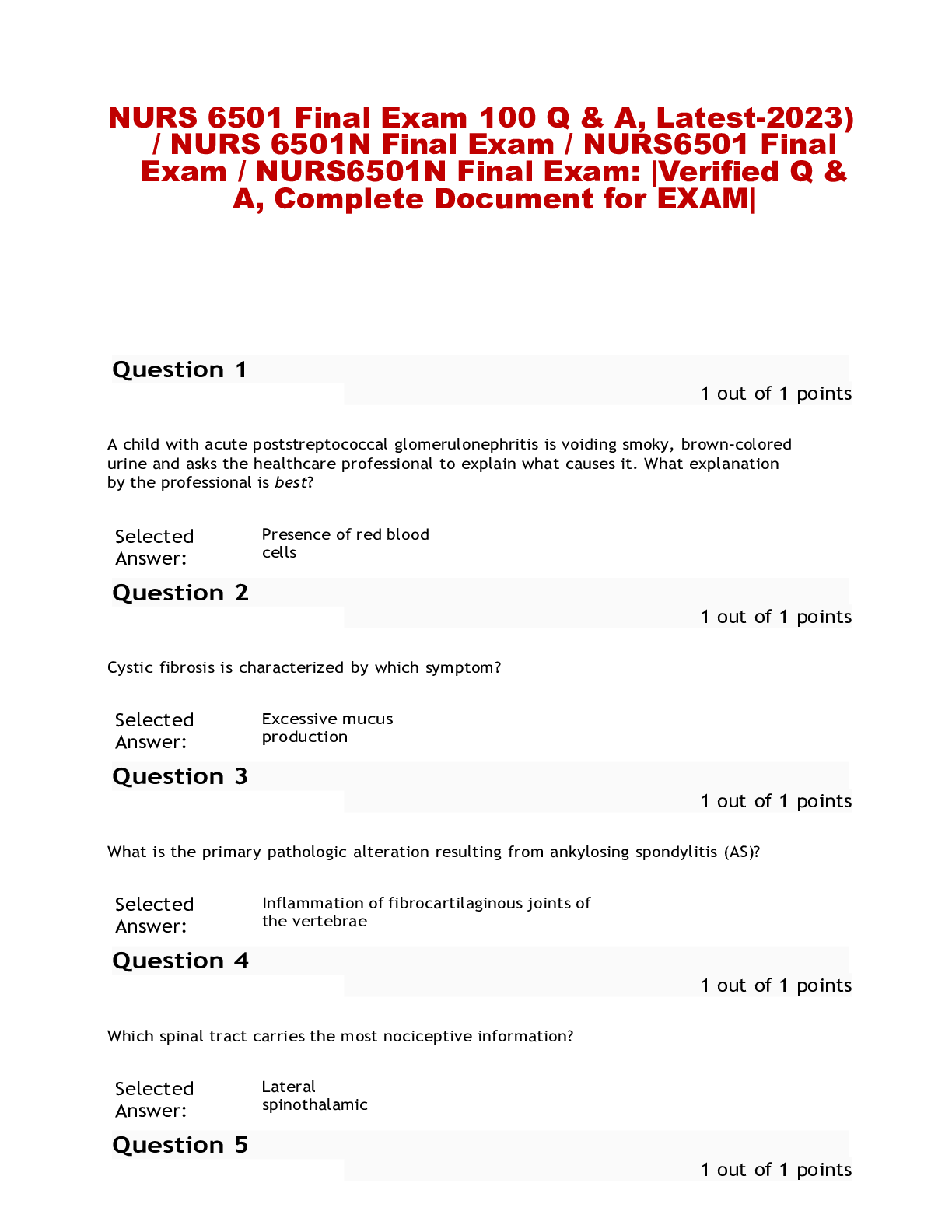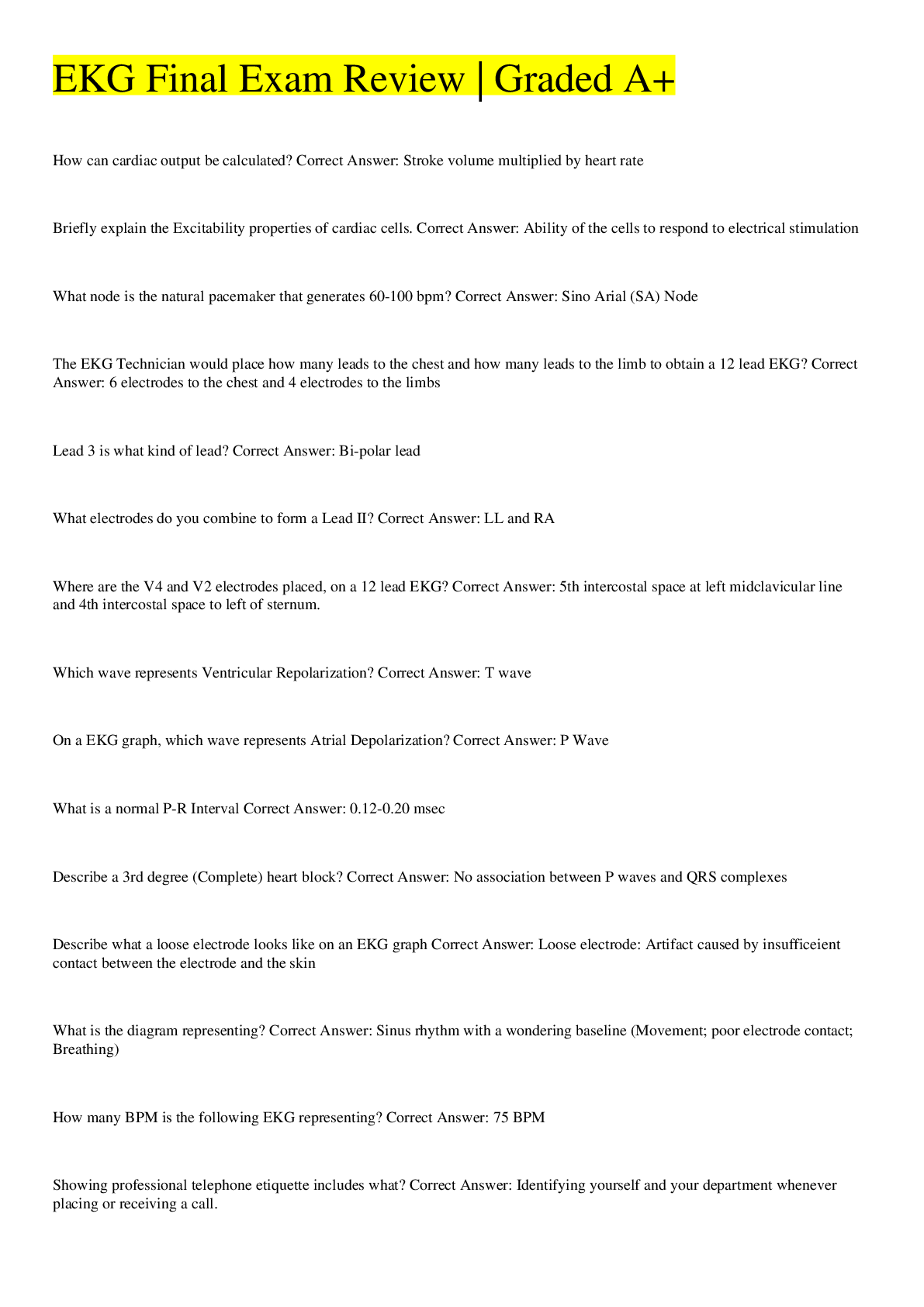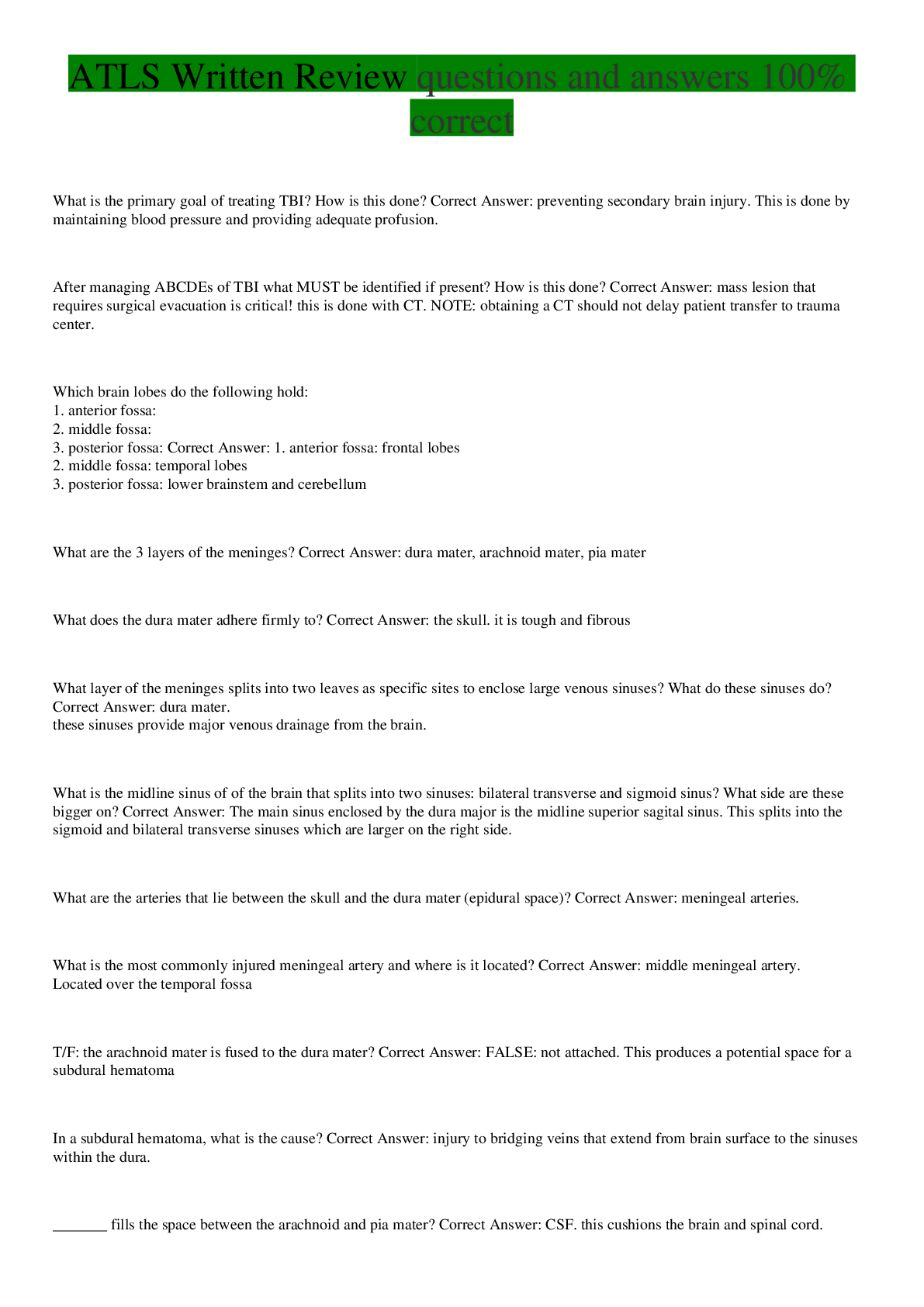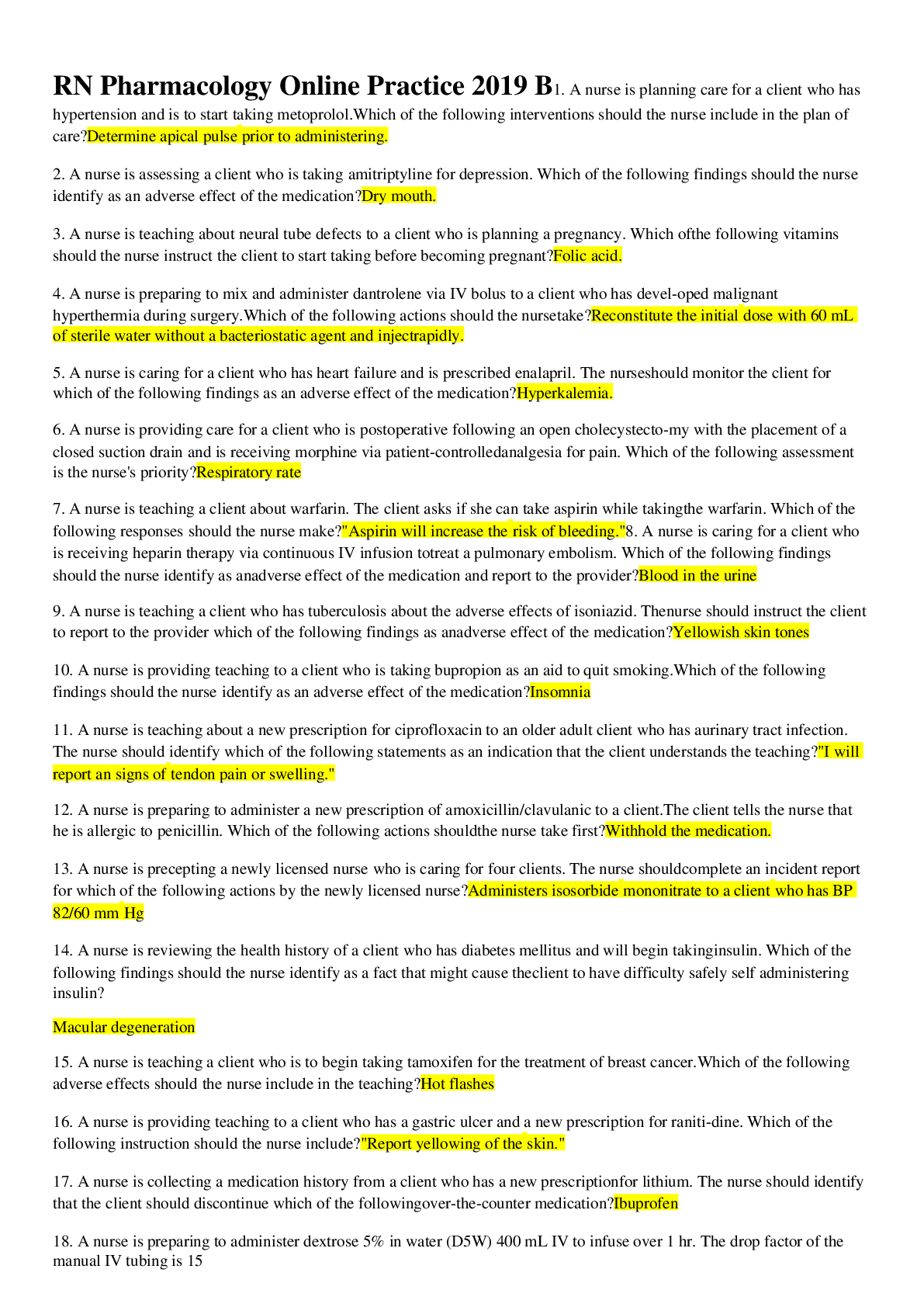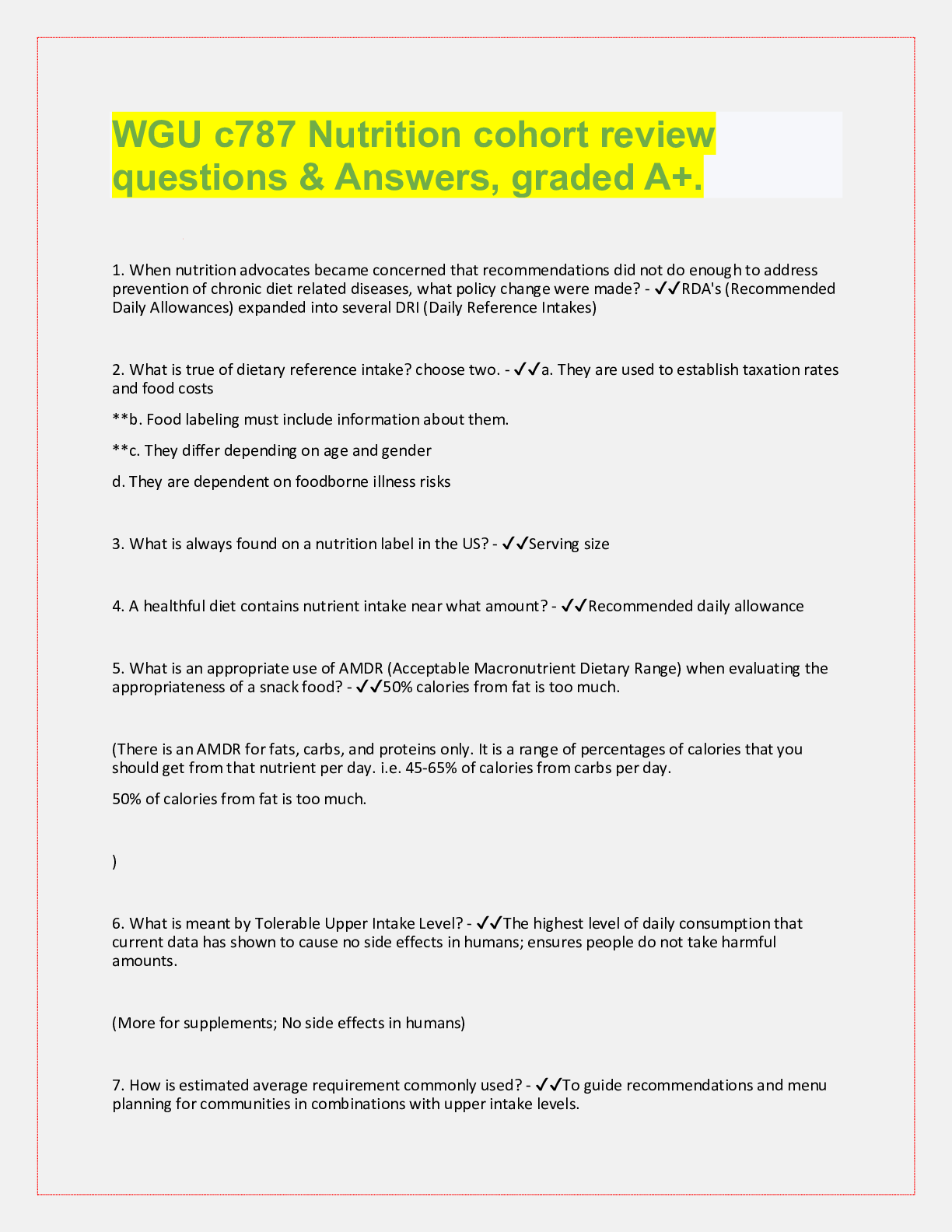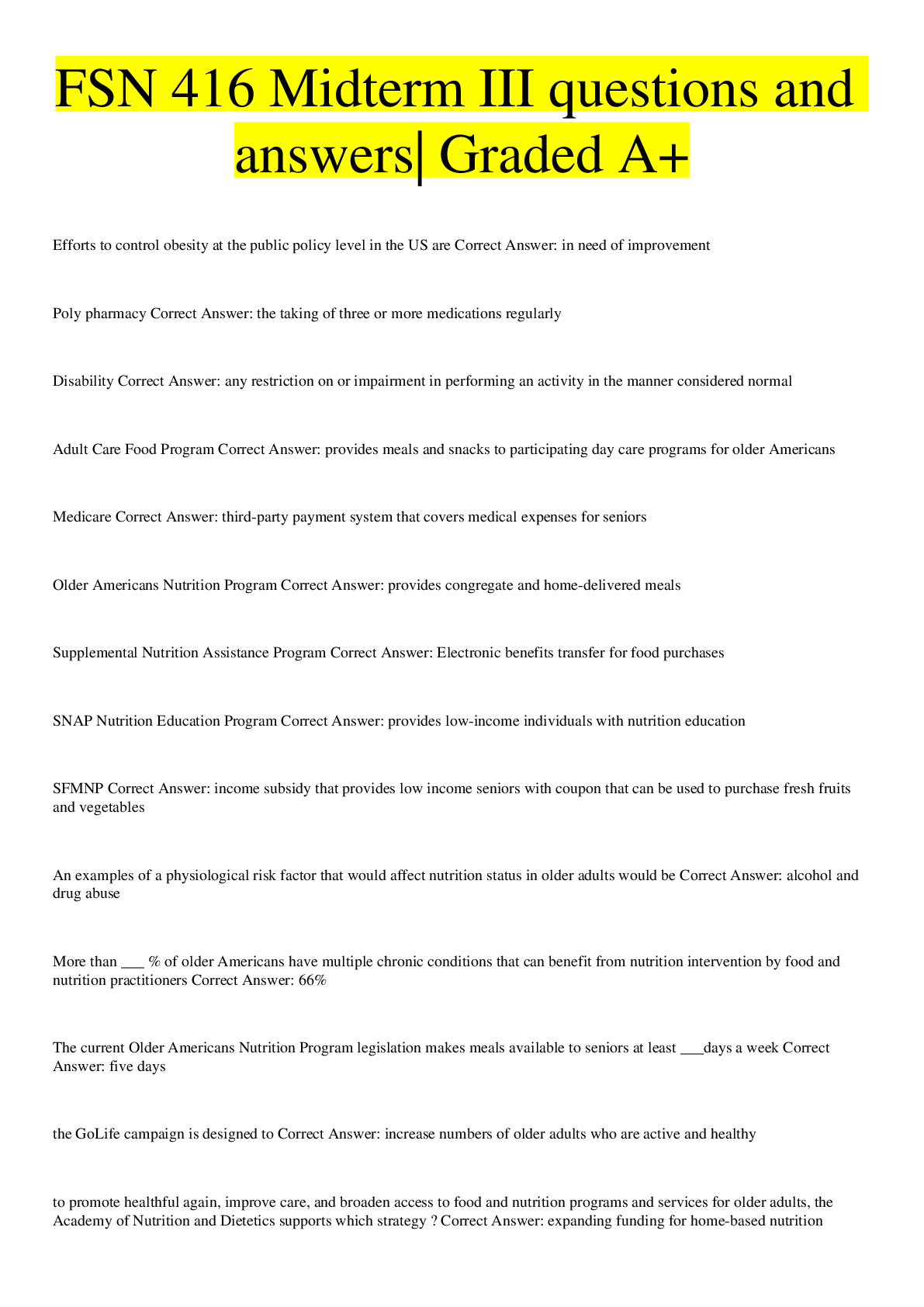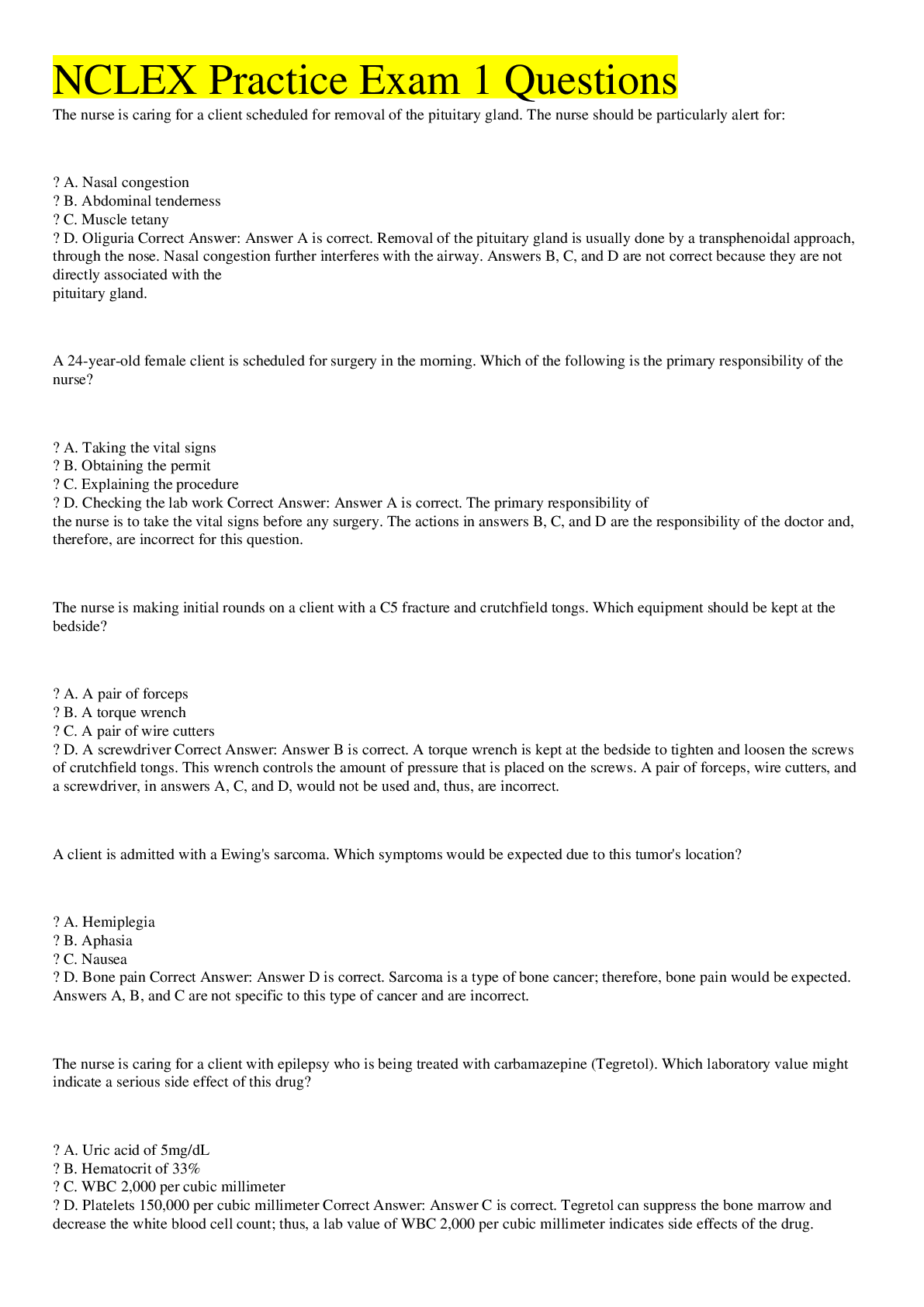NURS 649 Ped - Respiratory Syncytial Virus HESI | GRADED A
Document Content and Description Below
Respiratory Syncytial Virus (RSV) Bronchiolitis Page 1 1. Assessment When the nurse enters the room she finds Grace crying in her mother's arms. The nurse and Wendy calm Grace, and then the ... nurse auscultates the infant's lungs. Coarse bilateral wheezes are detected, but the infant does not appear in acute distress at this time. 2. 1.ID: 6975234130 What action should the nurse take next? A. Perform nasal suctioning. B. C. D. Document assessment findings. Awarded 1.0 points out of 1.0 possible points. 3. 2.ID: 6975234113 What technique(s) should the nurse use to assess for respiratory distress? (Select all that apply.) A. Place a pulse oximeter on a big toe of the baby’s foot. Correct B. C. Percuss for hyperresonance. D. Inspect oral mucosa for dryness. E. Count the infant’s pulse and respiratory rates. Correct Awarded 1.0 points out of 1.0 possible points. 4. The nurse continues the assessment. 5. 3.ID: 6975234124 Which assessment finding exhibited by Grace warrants immediate intervention by the nurse? A. Rectal temperature of 100.0° F. B. Dry mucous membranes. C. Minimal response to stimuli. Correct D. Anterior fontanel is soft and flat. Awarded 1.0 points out of 1.0 possible points. 6. Grace is having some increasing respiratory distress. The nurse suctions her mouth and nasal passages with a bulb syringe to clear secretions and emergency blow-by oxygen is given. Grace is now responding to Wendy's voice. Wendy attempts to bottle feed Grace. The nurse observes that the infant has difficulty sucking and keeps spitting out the nipple. The nurse notes that Grace still has thick nasal secretions and that her respiratory rate has increased to 50 breaths per minute with her sucking effort. 7. 4.ID: 6975234126 What action should the nurse take? A. Cut a bigger hole in the nipple. B. Suction the infant's nose again. Correct C. Place Grace in an infant seat. D. Call the HCP to obtain further orders. Awarded 1.0 points out of 1.0 possible points. 8. Soon after, the HCP evaluates Grace and determines that she has respiratory syncytial virus (RSV) prescribes the following: NPO status, IV fluids, Ventolin (albuterol) aerosol, diphenhydramine (Benadryl) 0.5 mg/kg every 8 hours PO, oxygen set to ½ liter per nasal cannula, and nasal suction with normal saline prn. Additionally, the HCP prescribes 5% dextrose and one-half normal saline with 20 mEq potassium chloride at 100 mL per kg over 24 hrs. Grace weighs 12 pounds. 9. 5.ID: 6975234120 For how many milliliters per hour will the nurse set the IV pump? (Enter numerical value only. If rounding is necessary, round to the whole number.) Correct Responses A. 23 Awarded 1.0 points out of 1.0 possible points. 2. After several attempts to start the IV elsewhere, the nurse prepares to start the IV in the infant's scalp. 3. 6.ID: 6975234116 What should the nurse do next to best promote atraumatic care and to get the IV in place in a timely fashion? A. Place EMLA cream on several potential IV sites. B. Ask the mother to step out of the room to increase her comfort. C. Give the infant sucrose solution (Sweet Ease) on a nipple to suck during the procedure. Correct D. Place the infant supine and get another nurse to gently restrain the child during the procedure. Awarded 1.0 points out of 1.0 possible points. B. The IV line is placed in a peripheral vein in the right hand side of the scalp and secured with tape. Grace's oxygen saturation level on room air is 90%. C. 7.ID: 6975234111 What action should the nurse take? A. Reassess in 30 minutes. Inaction places the child at risk for further distress. B. Notify the HCP. This is not necessary because there is already a prescription for oxygen. C. Chart findings. D. Apply O2 at ½ liter by nasal cannula as prescribed. Correct Awarded 1.0 points out of 1.0 possible points. Page 2 1. Medication Administration 2. O2 is applied as prescribed, and the saturation level is maintained at 94%. 3. 8.ID: 6975234148 The nurse reviews Grace's medication prescriptions. Which medication should the nurse question prior to administration? A. Potassium chloride. B. Saline nasal drops. C. Diphenhydramine (Benadryl). Correct D. Albuterol (Ventolin). Correct Awarded 1.0 points out of 1.0 possible points. 4. After clarifying the prescriptions, and stabilizing the infant’s oxygen saturation level to 94%, the nurse prepares to transport the infant to the pediatric unit. 5. 9.ID: 6975234150 What nursing diagnosis has the highest priority for Grace? A. Ineffective airway clearance. Correct B. Activity intolerance. C. Risk for fluid volume deficit. D. Interrupted family processes. Correct Awarded 1.0 points out of 1.0 possible points. Page 3 1. Management: Delegation Grace is tachypneic and is on oxygen at ½ L/minute via nasal cannula. The HCP also prescribes cardiac telemetry to start upon Grace's arrival at the pediatric medical unit. 2. 10.ID: 6975234157 Which staff member should be assigned to transport Grace to the pediatric unit? A. A new graduate nurse starting an ED internship. A new graduate will not have the experience to handle the sick infant. B. An experienced unlicensed assistive personnel (UAP) who is certified in cardiopulmonary resuscitation (CPR). UAPs do not have the experience necessary to transport a sick infant. C. An experienced pediatric registered nurse (RN) floated to the ED for the day. Correct D. A licensed practical nurse (LPN) who is orienting to the ED. Awarded 1.0 points out of 1.0 possible points. 3. While Grace is being prepared for transfer, the ED nurse calls the medical unit and gives report to the charge nurse. The charge nurse reviews the current staff assignments to determine who should be assigned the care of the infant. 4. 11.ID: 6975234154 Which staff member should the charge nurse assign to care for Grace? A. An RN caring for a 6-year-old who is receiving chemotherapy. B. An LPN caring for a 14-year-old following an appendectomy. C. An RN caring for a 9-month-old with pneumonia. Correct D. An LPN caring for an infant in a hip spica cast. Awarded 1.0 points out of 1.0 possible points. Page 4 1. Family-Centered Care The infant and her mother are escorted to the medical pediatric unit. Wendy states "I am so worried about my baby. I feel like the worst mother in the world. Is there anything that I can do to help my child?" 2. 12.ID: 6975234161 What statement by the nurse reflects the philosophy of family-centered care? A. "Don't worry Wendy, I am going to take good care of Grace." B. "Would you like to speak to the chaplain about your concerns?" C. "You're tired; why don't you go home, and let us take care of Grace." D. "While you hold Grace, we can talk about her diagnosis and care." Correct Awarded 1.0 points out of 1.0 possible points. Page 5 1. Complication Later in the day, the nurse hears the infant’s alarm go off and goes to the child’s room. She assesses the infant who is grunting and has nasal flaring and retractions. The infant's respirations are at 62, and her pulse oxygen level is 80%. 2. 13.ID: 6975234164 What action should the nurse take? (Select all that apply.) A. Reposition the infant in an elevated position. Correct B. Vigorously stimulate the child. Vigorous stimulation of an infant may cause harm to the infant. C. Begin CPR. This intervention is not necessary at this time. D. Notify the HCP. Correct E. Activate the hospital rapid response team to come to the bedside. Correct Awarded 1.0 points out of 1.0 possible points. 3. When Grace's condition does not improve, the nurse notifies the HCP, who arranges for the infant to be transferred to the pediatric intensive care unit (PICU). After assessing the infant, the HCP decides to administer ribavirin (Virazole) by aerosol. 4. 14.ID: 6975234166 What precautions should the PICU nurse initiate while Grace is receiving this medication? A. Contact isolation. B. Restrict pregnant caregivers. Correct C. Fall precautions. D. Restrict family visitation. Awarded 1.0 points out of 1.0 possible points. 5. Grace is placed in a mist tent that will deliver the ribavirin (Virazole) over an 18-hour period during the day. Wendy asks the nurse if Grace could have any type of toy or activity so that she will not feel alone while she is in the tent by herself. 6. 15.ID: 6975234171 What type of toy should the nurse recommend? A. A stuffed bear. B. A musical mobile. Correct C. A plastic doll. D. Plastic blocks. Awarded 1.0 points out of 1.0 possible points. Page 6 1. Discharge Teaching 2. Three days later, Grace's condition improves, and she is transferred back to the pediatric unit. Grace is scheduled for discharge in 2 days if she remains stable. Wendy is anxious to learn how to care for Grace at home. The nurse begins by teaching the mother about nasal suctioning because the symptoms of cough and nasal congestion will persist for up to 2 weeks after the acute phase of the illness. 3. 16.ID: 6975234143 After gathering exam gloves and a bulb syringe, the nurse should include what other equipment when gathering supplies to teach the mother how to perform nasal suction? A. Sterile gloves. B. #8 suction kit. C. Nasal saline drops. Correct Saline is used to loosen secretions prior to suction. D. 3 ml of sterile water. Awarded 1.0 points out of 1.0 possible points. 4. The nurse completes the initial demonstration, and Wendy performs a successful return demonstration. Wendy asks the nurse, "What if I can't remove any mucous when I suction Grace's nose?" 5. 17.ID: 6975234136 How should the nurse respond? A. "The amount of mucous is less important than Grace's behavior after the treatment." Correct B. "You will need to suction her again until you obtain at least a spoonful of mucous." C. "Continue to insert additional saline nasal drops until the mucous can be removed." D. "Call Grace's HCP if you are unable to remove any mucous when you suction her." Awarded 1.0 points out of 1.0 possible points. 6. Wendy says that she feels comfortable with the suctioning procedure. Two days later Grace is ready for discharge in the morning. Wendy states that she is fearful Grace may become ill again and asks the nurse what she can do to help prevent that from happening. 7. 18.ID: 6975234140 How should the nurse respond? A. "There is no way to prevent illness." B. "Use of proper hand hygiene and avoiding contact with the sick can reduce the risk of infections." Correct C. "Keep the infant in the house away from all visitors until her immune system is strong enough to protect her." D. "Have people who come in contact with the infant wear a mask." Awarded 1.0 points out of 1.0 possible points. Page 7 1. Case Outcome The next morning, Grace is discharged from the hospital. The mother will follow up with the HCP in 1 week. Wendy states that she appreciates the support and care that she and her daughter received during Grace's hospitalization. [Show More]
Last updated: 1 year ago
Preview 1 out of 12 pages
.png)
Reviews( 0 )
Document information
Connected school, study & course
About the document
Uploaded On
May 17, 2021
Number of pages
12
Written in
Additional information
This document has been written for:
Uploaded
May 17, 2021
Downloads
0
Views
32






.png)











